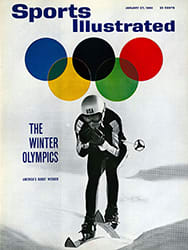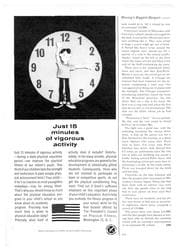
Simple, lightweight ski gear—and sturdy legs—is all that is required for touring
As lift lines grow longer and slopes more crowded, a small band of adventurous skiers are rediscovering the joys of touring and cross-country skiing, sports that almost disappeared in the U.S. with the advent of ski tows in the 1930s. The best equipment comes from the Scandinavian countries where these sports are the most popular.
The Kongsberg ski (below) is a good example of a standard Nordic touring ski. It is made of multilaminated hickory and birch and is narrower and lighter than an Alpine ski (this enables a skier to move easily over the snow). O. U. Sports of 1123 Second Avenue, Seattle, imports the ski ($37.50).
The binding in the illustration is extremely simple: it is merely a U-shaped clamp that holds a boot against the toeplate so that the heel is free to move up and down in the bent-knee stride of the cross-country skier. Rottefella of Sweden makes the binding, and it can be purchased from John Wictorin of Silva, Inc. (71 Overpeck Avenue, Ridge-field Park, N.J.) for $5.95.
A cross-country boot is cut much lower, and has greater flexibility than a regular ski boot. The one shown above costs $21.50 at Wictorin's.
The ski pole in the drawing ($9.95 at Wictorin's), like the boot and binding, is for the more proficient cross-country skier. It is made of bamboo, weighs about half as much as a standard steel pole and has cork handles that make it easy to grip.
For skiers bent on exploring high-altitude snowfields in the West, ski shops advise buying equipment almost identical to that used by Alpine skiers during pre-ski tow days. Bonna's Mountain Ski is wider than a regular touring ski but is still narrower and lighter than a modern downhill ski. Like the Kongsberg Touring Ski, it is made of hickory and birch with hardwood edges and is sold by O.U. Sports for $39.95.
Even boots for mountain touring remind one of early Alpine skiing in America. Wictorin's ($19.50) are lightweight, flexible and do not have a steel shank in the sole. They do, however, give slightly more support than the cross-country boot. The Marker Clou swivel plate in the drawing is also well suited for high-country skiing. It converts a touring binding to an Alpine version (to get down a mountain), with a lateral safety release, by removing the two front screws in the toeplate and putting the cables back in place. The swivel action thus gives needed safety to skiers on unpacked slopes far from the ski area. Dartmouth Skis, Inc. of Hanover, N.H. distributes them ($6.95).
The Marker Steckbacken clamp can also be used to convert downhill skis into touring skis. It is a toeplate, adjustable to any boot size, that simply slips into the notch of a Marker toepiece and behind the front cable hooks (above). Release the cables from their notches, and you are ready to tour. It costs $4.95 at Dartmouth Skis.
ILLUSTRATION
BAMBOO POLE
ILLUSTRATION
CROSS-COUNTRY BOOT, BINDING
ILLUSTRATION
TOURING SKI
ILLUSTRATION
CORK HANDLE
ILLUSTRATION
MARKER CLOU
ILLUSTRATION
BONNA SKI
ILLUSTRATION
TOURING BOOT
ILLUSTRATION
MARKER CLAMP

